|
FAQs on Carbon Dioxide and Planted Tanks:
Compressed Gas Types
Related Articles: Carbon dioxide and the planted freshwater
aquarium by Neale Monks, CO2 Canopies,
Related FAQs: CO2
& Planted Tanks 1, CO2 &
Planted Tanks 2, CO2 Canopies, & FAQs on CO2 Planted Tanks: Rationale/Use, Sources, Yeast-Bottle Types, Control/Delivery, Measure, Dangers,
|
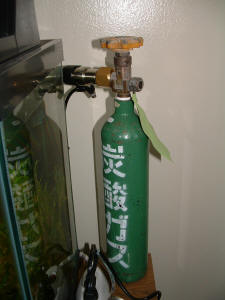
|
|
Large Planted Tank with CO2 9/19/10
Hello,
I have started a 150 gallon planted freshwater tank and have a
previous CO2 system I would like to add. My dilemma is 1) how do
I measure how much CO2 I need for such a large tank? 2) I have a
small ceramic glass diffuser from ADA that is about 1"
diameter. It says it is for up to 20 gallons which is too small
for my tank. What do I need to use as a diffuser for such a large
size tank? I have upgraded to a used 0.6 kg CO2 tank (please see
picture) and had it modified to attach to a simple CO2 system
bought in a local pet store. I have a glass bubble counter to
suction to the outside of the tank and a glass CO2 reader which
shows yellow, green, or blue depending on how much is in the
water. Should I just put the diffuser in there under the output
tubes and see what the CO2 reader says in a day or two? I have
attached pics of when It was hooked up to my 20 gallon quarantine
tank I was using for plants. I have invested too much money in
this already and am not really looking to add to it if I
don't absolutely have to. Is there any way I can use this
system in my large tank?
Thank you all!
Lisa
<Lisa, having seen photos of your tank, I'm almost 100%
sure that CO2 will make no difference at all. Can I strongly urge
you to focus on [a] light intensity and [b] choosing the right
plants for your ambient lighting levels, water chemistry, water
temperature, and water current. I have an article about all of
this coming in the next WWM Digital magazine which should be up
in the next week. But in brief, there are two ways to decide how
much CO2 to add. The first is trial-and-error. Assuming intense
lighting, if you add CO2 at the tiniest amount you can in
bubbles/second and wait for an hour, you should see
"pearling" of oxygen bubbles on some plants. If not,
add a tiny bit more. Repeat as required, all the time checking
that [a] the fish don't look stressed and [b] there isn't
a wild pH swing (there will be a slight pH decrease as you add
CO2, but if it goes from 8 to 6 that's too much!). This
approach is hit-and-miss and not terribly safe. The better
approach is to use a CO2 test kit to measure the dissolved CO2.
This should be between 10 and 20 mg/l. Add sufficient CO2 for a
concentration of 10 mg/l, wait a couple of weeks, and if plant
growth still isn't as good as you'd like, increase to 15
mg/l, and then a couple weeks later to 20 mg/l if needs be.
Again, make sure the fish stay happy.
Above 25 mg/l CO2 will quickly kill your fish; in fact using CO2
is quite a good way to euthanise fish! So be very careful. There
is a relationship between pH and CO2 concentration assuming you
know the carbonate (not general!) hardness, so you can use a pH
test kit to measure CO2 concentration. The formula is 3 x
carbonate hardness (in degrees KH) x10(7-pH); thus if carbonate
hardness is 5 degrees KH and the pH is 7.6, then the amount of
carbon dioxide in the water will be 3.78 mg/l. If you're
maths-phobic, then using a CO2 test kit will be safer. With all
this said, your aquarium doesn't have enough lighting for CO2
to make much difference either way. You'd get far better
results concentrating on plants adapted to relatively low light
levels. These will find the CO2 produced by your fish and the
filter more than enough, and even more so if you added a proper
substrate, since microbes in the gravel and sand produce CO2 as
well. Anubias, Java fern, Cryptocoryne wendtii, Vallisneria
spiralis, hybrid Aponogeton, floating Indian fern, Amazon Frogbit
-- all these should do fine in an aquarium with 1-2 watts/gallon,
without the need for CO2. There is a VERY COMMON misconception in
the hobby that CO2 is the thing that makes or breaks plant growth
in aquaria. To some degree, the people selling CO2 appliances
foster this idea. But it is COMPLETELY WRONG. While CO2 can make
good planted tanks even better, it won't turn around a poor
or mediocre one. It's a bolt-on goody for already successful
systems. Cheers, Neale.>
|
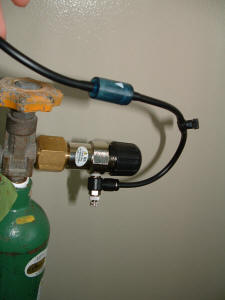 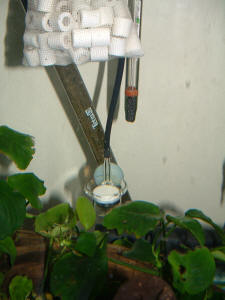
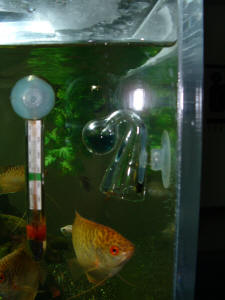 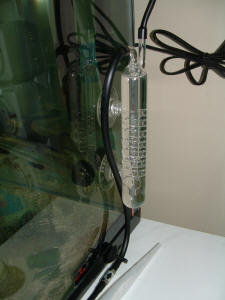  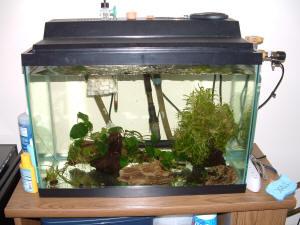 |
CO2 in planted tanks 9/22/08
Hello,
I have a question regarding CO2 levels in a planted aquarium.
<OK.>
First I'll start by telling you about my setup and my problem. I
have a 20L planted aquarium.
<Do you really mean twenty litres? That's a bucket! Or is this a
"20 gallon" tank in a long format?>
Plants include Ceratopteris thalictroides, Nymphaea zenkeri ,
Lilaeopsis brasiliensis, Hygrophila difformis, Hygrophila corymbosa,
Echinodorus ozelot -- one of my favorite plants, grows like a weed,
Hydrocotyle leucocephala, and Vesicularia dubyana. Inhabitants are 2 LF
zebra Danios, 2 LF leopard Danios, 1 LF gold Danio, 1 LF blue Danio, 1
female pearl Gourami, 7 Otocinclus, 1 ghost shrimp, and 2 cherry
shrimp. At one point I put a couple MTS in there to keep the substrate
turned where I can't gravel vac, but I haven't seen any
since.
<You won't! Melanoides be well hidden by day.>
The tank is drilled and plumbed to a 5 gallon sump. I use a Rio 1100
for the return pump, and a Visi-therm Stealth heater (can't
remember wattage... 100 or 150) is in the bottom of the sump. I made a
couple filter socks out of 50 micron felt for mechanical filtration,
and I clean them weekly. I don't have any other filtration, I rely
on plants and 5 gallon weekly water changes to take care of the
bio-load. Lighting is a 2x24W T5 HO fixture, with 6700K bulbs. I have a
DIY yeast CO2 system, consisting of two 2-liter bottles. I mix 2 cups
sugar, 2 cups water, and 1/4 teaspoon active dry yeast into the
bottles. I replace the old mixture every two weeks, and try to
alternate the bottles so that I change out the first on one week, and
the second on the next week. I know they're producing CO2 because
they develop a nice foamy head a few hours after I mix it, and when I
dump out the old mixtures they smell strongly of beer, though I've
noticed that some mixtures are stronger than others. I used this
website to set up my CO2 system:
http://www.qsl.net/w2wdx/aquaria/diyco2.html. The only difference is
that I connected it to the Red Sea CO2 Reactor 500, instead of making
my own out of a powerhead. My light is on from 11 am - 9 pm every
day.
<Sounds like a nice tank.>
I feed once a day, and I rotate between a flake mixture, freeze-dried
daphnia, freeze-dried bloodworms, and freeze-dried Tubifex (all
Hikari). The fish consume everything within a minute, and all have
well-rounded bellies. I'll occasionally feed algae wafers if my
tank looks bare of soft algae or the Otos don't look as plump as
usual, but that is pretty rare.
<OK.>
I do 5 gallon water changes every week to two weeks using RO/DI water
(getting that system was the best investment I ever made) reclaimed
with RO Right. I usually add about 1 mL of Seachem Flourish 1-2x per
week. I also had difficulties with shrimp dying immediately after
molts, and the problem seemed to be resolved when I started adding
about 1 mL of Kent Marine liquid calcium per week and 2 drops of Kent
Marine liquid iodine per week. I test the water weekly just before
doing water changes. The tank has been set up since August 19, and even
though I had to put all the fish in at once a few days after setup
(moving from an old tank) I never saw any spike in ammonia or nitrite.
I attribute this to the large number of plants and the large mesh bag
full of gravel from the old tank that I put into the new sump.
<Agreed; healthy plants will consume some ammonia straight from the
water, and transferring live substrate from one tank to another will
"seed" the new filter quickly.>
My parameters average as follows:
Nitrate - 15 ppm
Nitrite - 0
Ammonia - 0
pH - 7.4
KH - 2 degrees
GH - 4 degrees
Temperature - 77F
<A bit on the soft side for general fishkeeping, but provided your
pH is stable through the day and between water changes, such conditions
are certainly favourable for many fish. Do bear in mind many plants *do
not* like soft water, notably most Vallisneria, some Cryptocoryne spp.,
and some Echinodorus spp. But there are numerous others. Do review the
needs of each plant species you have, and check this hardness level is
appropriate.>
I have measured pH at different times of the day, including early in
the morning before the tank has received any light, and it's always
7.4. The KH is also always constant. According to most CO2 charts, this
means that my CO2 is only about 2 ppm, which isn't nearly as high
as I'd like it to be for the plants. My plants are growing, but not
very quickly, and some of the slower ones are getting a fine hair algae
on the leaves, as well as hard spot algae. I've also noticed some
Staghorn algae here and there, but fortunately it's not growing
very quickly. The only plant that really seems to be thriving is the
floating water sprite -- I have to remove about a handful a week or it
will shade out the other plants.
<Floating plants will usually grow rapidly if they're happy,
though they do cut out light and more dangerously consume large amounts
of trace elements from the water column. It's worth making the
point that while floating plants are easily satisfied with liquid plant
fertiliser, rooted plants hardly ever are. I didn't see anything on
the substrate used here, and would caution you not to rely on liquid
plant food for your rooted plants. Or put another way, I've never
had success doing that, whereas when I've used a rich substrate
(pond/aquatic soil plus sand/gravel) my plants have always done very
well.>
I would think that two 2-liter bottles for CO2 production would be
sufficient for a 20 gallon tank. I can't figure out why it's
not producing more CO2.
<Theory is one thing, but if in practise you find this system
isn't adequate, and you've checked its working as it should,
well there you are -- case closed. While I'm all in favour of the
"Estimative Index" method as a guideline for setting up and
maintaining planted tanks, to some degree you can't close your eyes
to the facts if the practise isn't working out. So in this case,
you may need extra CO2. That said, I've never yet seen a planted
tank where the absence of CO2 was stopping the plants from thriving. In
my experience, CO2 makes working tanks really shine, but it doesn't
turn bad tanks into good ones. So if you feel that plant growth is
poor, do check other factors as well: lighting, substrate type, water
chemistry. Hydrocotyle and Lilaeopsis for example need huge amounts of
light to do well; to be honest even two T5 tubes are unlikely to be
giving the sheer intensity of light they need. Double that number of
tubes and you might be in business. You can usually tell by looking at
growth: if the stems have long gaps between relatively small leaves,
then there's not enough light.>
Would the fact that I inject the CO2 into the sump instead of the main
tank affect results?
<Possibly; any splashing of the water has the potential to drive the
CO2 out of solution.>
I try to keep surface movement as minimal as possible, but does it have
to be completely still?
<Ideally, yes, but since that isn't practical in the aquarium,
the best you can do is minimise turbulence.>
I can't really afford to add more bottles -- I go through a ton of
sugar as it is. I also read something on this website saying that
phosphate can affect CO2 readings:
http://www.csd.net/~cgadd/aqua/art_plant_co2chart.htm. However, it
didn't say how it would affect them -- would it give a false high
or a false low?
<I don't know I'm afraid, never come across this statement
before; would encourage you to contact the author directly.>
I haven't found anything else to confirm, deny, or elaborate on
that statement. I can't tell what my phosphate levels are. I use
the API Phosphate test kit. The scale goes from a yellow-green at 0 ppm
to a blue-green at 10 ppm, and the color I get is even more yellow than
the lowest number, so I don't know what that means.
<It means you have minimal phosphate; in itself no big deal as this
is unlikely to be limiting if plant growth isn't fast.>
So I guess my main questions are 1) Can the presence of phosphates
affect the accuracy of CO2 measurements using the pH/KH relationship,
and 2) Is there anyway to improve the amount of CO2 in my tank without
buying an expensive CO2 injection system?
<To answer the latter question, the electronic dosing kits are
indeed very useful and worth investing in. But that said, I
wouldn't drop the cash on an aquarium that wasn't already very
promising. I suspect that money spent on substrate and lighting will
deliver a much great bang for your buck.>
Thanks so much for reading the long email. Any help is appreciated.
-Tamla
<Cheers, Neale.>
|
CO2 Alternatives 07/20/2008 Hello....I have a 29 gal FW
community tank using a Whisper 2 filter. It's illuminated
with a 10K light for about 14 hrs/day. I keep the Ph at 6.8 to
7.0 and ammonia is nonexistent due to my mixing Zeolite with my
charcoal filter media. <Zero ammonia should have nothing
whatever to do with the Zeolite, which you shouldn't be using
in a community tank anyway. Unless you have money to burn, you
get much better results with biological filtration, especially at
a neutral pH. My thoughts on carbon in freshwater tanks are well
known here at WWM -- basically I consider it a waste of money.
But again, if you don't mind spending money on stuff you
don't need, by all means stick with it! If, on the other
hand, you want good value and good water quality, simply through
out the carbon and Zeolite, replace the space in the filter with
good quality biological media (e.g., ceramic noodles) and do
large, regular water changes (e.g., 50% weekly) instead.> I
regularly add Seachem's Trace, Flourish, and Potassium and I
place a phosphorus pad alongside my filter bag to minimize algae
growth. At one time I included Seachem's Nitrogen in my
additives, but that resulted in a huge algae bloom. <You
shouldn't really need to add much stuff to a planted tank
assuming you have a decent substrate to start with. The fish
provide ample nitrate and phosphate. All you really need to add
are trace elements, especially iron. Standard issue plant
fertiliser will do this.> To remedy sluggish or nonexistent
plant growth I installed the CarboPlus CO2 system a few years ago
and the improvement is mixed, at best. <Lacklustre plant
growth is almost always down to two things: firstly light
intensity, and secondly substrate quality (assuming of course
you've bought true aquatic plants and not terrestrial plants
-- to often widely sold). You say nothing about light intensity,
the 10,000K refers to the *colour* of the light, not the
intensity. For standard plants, you're aiming at 2-3 watts
per gallon. The actual colour of the lights couldn't matter
less, as plants seem to be far more adaptable than, say, corals.
CO2 is "icing on the cake" -- it makes a good system
better, but it won't turn around a failing system. If you
remember your high school biology, when you studied
photosynthesis and limiting factors, you'll recall that CO2
is a limiting factor. Increasing light intensity speeds up
photosynthesis up to a point, and then raising the CO2
concentration speeds up photosynthesis still further.>
I've been considering a gas CO2 system but the tank's
location gives no opportunity to hide a 5 lb. CO2 bottle. Someone
suggested a yeast reactor coupled to a PGP Power Reactor CO2
system built by Plantguild Products. Does anyone have any history
or comments on the effectiveness of such an approach? <Yeast
reactors can work well, but they're fiddly and require
careful usage. On the flip side, they're relatively cheap to
run. CO2 bottles are easier but more expensive. The best systems
of any kind are electronic, with automatic devices that add the
right amount of CO2. If you're going to invest in upgrading
an existing CO2 system, that's perhaps the most sensible
approach. But if you're finding your plant growth is poor at
the moment, then I seriously doubt that CO2 is the key factor, so
I'd review other aspects. Are the plants suitable for your
tank? Are you providing the water hardness they want? Is the
water too warm or too cold? What substrate did you use? What is
the intensity of the lighting? When did you last replace the
lights?> As a side note, if this unit's power head is
noisier than my Whisper filter, it's a no-no. Thanks for your
comments! Ken <Can't really comment on this; properly
build powerheads should be close to silent. If you are finding
yours make excessive or rattling noises, it may be
faulty/misused. Air bubbles for example make a racket when inside
impellers. Cheers, Neale.>
Re: CO2 Alternatives 7/20/08 Thanks
Neal....obviously you've given me a TON to think ....and
rethink about. KLP <Good stuff. Keep thinking, reading, asking
questions! High end planted tanks are very difficult to set up
and maintain, and argue *at least* as much work as a reef tank.
You want to expend your time and money as carefully as possible.
Cheers, Neale.>
|
New fresh water tank setup 10/25/05 Hey everyone,
<hello> I've been using WWM for tons of research and I
finally have my first set of questions. I've been doing saltwater
for about 6 months now and it's been going great. My g/f wants to
get a fresh water tank for her house. I haven't done fresh water
for quite some time and even then I never did plants (this will be a
fully planted system). I'll just list out what I want to get and
let me know if I'm on the right track. The tank is going to be a
Clear-For-Life 75g and I plan on running 4x96 PC retrofit. <good>
I've read actinic isn't great for freshwater so this will be
all 6700 to 10000k daylight. The filtration I want to use is the
Marineland Emperor 400. I don't know that I really want to go
canister but if it's essential then I will. <canister provides
better mechanical filtration!> The substrate is what is confusing
me. I read that fluorite is hard on the stomach of Cory cats and that I
should have a top layer of smoother gravel. <that is true>
I've also run across floral base which seems to be less coarse.
<I wouldn't worry about the Cory cats too much> Should I just
stick with a 2" base of fluorite and a top layer of a different
gravel? <that should be fine> What would you recommend for the
top layer of gravel? <I would just go with the fluorite...the Cory
cats should be fine> I imagine vacuuming will be out of the question
with a full plant system but will I need to worry about any bad
bacteria growing like Cyano? <not unless you have high phosphates,
nitrates, etc> I'm also a little confused about the
CO2 reactors. I don't want to do the DIY
but I also don't have quite enough money to buy a big fully auto
CO2 setup. Would something like the
Hagen CO2 Natural Plant System work? Would
this be enough for a 75 gallon or do I even need to worry much about
CO2 with this setup? <that is only
recommended up to 20 gallons...you would need something bigger than
that.> <<I have used two of these units on the same
tank.... will do for a larger system, if filled/maintained on a
staggered basis.... I staggered mine by two weeks. Worked adequately.
-SCF>> Thanks for having such a useful site and I greatly
appreciate any and all advice. -Craig <good luck, IanB>
|
|

